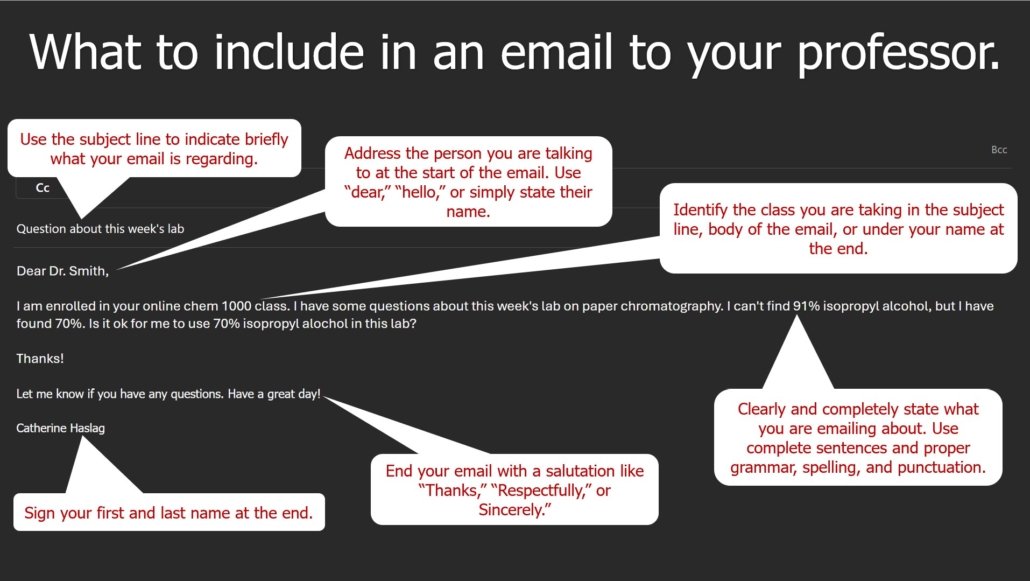Introduction
It is essential that we know how to communicate clearly and completely with each other. This includes during class time, during meetings, and in written communications. Think of this as an opportunity to develop professional communication skills before you enter your career field.
Below are expectations regarding professional communication. Please follow these guidelines when communicating with me, your classmates, and other faculty/staff at the college.
General Communication Etiquette
I encourage students to communicate with each other and with me during this class. Students can form study groups to help each other with the material and ask their teacher questions. I welcome questions from students. I am a resource here to help you succeed in this course. When communicating with your teaching and classmates, please abide by the following guidelines:
- Be respectful of everyone. If you wouldn’t say it to your grandma’s face, then it shouldn’t appear in a written communication to someone.
- Use complete sentences and thoughts in your email communications. The person you are writing to wasn’t involved in the train of thought you just had, so please provide enough information that they understand what you are talking about/asking.
- Be sure to state who you are, which class you are taking, and the reason for your communication each time you communicate with your teacher.
- Sign your emails with your first and last name. Creating a signature for your emails may be helpful to make this easier for you. Videos 1.0 and 2.0 demonstrate creating a signature in Outlook 365 and Gmail.
Video 1.0 – How to create a signature in Outlook.
Video 2.0 – How to create a signature in Gmail.
- Do your best to use proper grammar, spelling, punctuation, and capitalization in your messages. Texting lingo is not acceptable in an email.
- Proofread your emails to check for any of the above mistakes and the tone of your message.
- Do not use all capital letters in your communications. It will appear as if you are shouting.
- Be patient in waiting for your instructor and fellow students’ response. Not everyone responds immediately to texts and emails. In general, please provide at least 24 to 48 hours for people to respond before you follow up.
Above all, be respectful when communicating with each other. Disrespectful communication includes:
- Using foul or crude language.
- Using racial slurs or derogatory language.
- Attacking someone for their appearance or behavior.
- Calling someone names other than those they want to be addressed by.
- Threatening someone.
- Using very aggressive or threatening tone in your communication.
This kind of behavior can result in serious consequences for the user, including disciplinary action such as an F in the course or dismissal from a job.
Emails
Email communication is very common in today’s world. It’s important to know how to write a professional email. Figure 1.0 demonstrates some common things to include in all of your emails.
If you contact me via email, please be sure to include:
- Your full name (first and last). Do not assume your email address will automatically identify who you are. Always sign your emails with your first and last name for clarity.
- Please state which class you are taking. Most faculty teach several different classes. Telling them which class you are taking makes it easier for them to address your question.
- Include the reason for your email. Please use complete sentences, capitalization, and proper punctuation in your email so it is easier to read and understand your communication.
Failure to provide this information could delay the response to your request. Please allow 24 hours for a response, longer on weekends/holidays.
Texting
Some faculty are happy to talk with you via text. If you would like to contact me via text, please use the number indicated at the top of the syllabus. Please allow 24 hours for a response, longer on weekends/holidays.
When texting with your teacher, please identify who you are and which class you are taking each time you initiate a conversation via text. Don’t assume everyone saves all of their old text messages and can look back at previous conversations to see who you are.
Phone Calls
If you call, you must leave me a message. Many people do not return missed calls unless you leave a message. When you leave a message, please include the following information:
- Your full name (first and last);
- A phone number you can be reached at. Many faculty cannot access student phone numbers and cannot respond if you do not supply this information.
- Please state which class you are taking.
- The reason for your call.
Additionally, do not call repeatedly if someone doesn’t pick up. This may work for your friends, but doing this in a professional environment is disrespectful. Please leave a message if your call is not answered. I am very diligent about returning student calls, but you must leave a message. Calling repeatedly will not get you a response any faster than if you just call once and leave a message, as indicated above.
Most people also do not return missed calls without a message. This may work with your friends, but it isn’t how things work in professional environments. Please do not assume that someone will call you back because they missed your call. Please leave a message with your name, phone number, and reason for your call to ensure you will get a response.
Zoom Meetings
Video meetings are very common in this post-pandemic world. Zoom is one of the most commonly used video conferencing tools. Below are some tips to ensure you are prepared and respectful during Zoom meetings.
- Ensure you have the software you need downloaded to your computer. Include the link to any video calls in your calendar if possible. This will make connecting to meetings easier.
- Test your internet connection, microphone, and camera before the meeting starts.
- Turn your camera on. If you don’t want someone to see you, then please use the phone to call rather than schedule a video meeting.
- Set up a meeting space that is free from distraction and is quiet/conducive to a meeting. For example, use a room with a door or a quiet corner to meet rather than meeting in the middle of a busy living room or coffee shop.
- Use headphones if you must hold your meeting in a more public space.
- Be on time and present. Do not play on your phone or talk with others during your meeting.
- Have what you need out and ready to go before the meeting starts. For example, you will want to have a periodic table and calculator ready to use if you meet with me for questions about class.
- Present yourself like you are at work (no drinking, smoking, or vaping, groom yourself before the meeting, and dress appropriately). For example, it is inappropriate to lounge in your pajamas like you just woke up during a meeting or class.
It is essential that you put your best foot forward in oral and written communications in your academic and professional life. Following these guidelines will set you up for success in your academic and professional careers.
Originally posted: December 18, 2023
Last Updated: January 8, 2024


